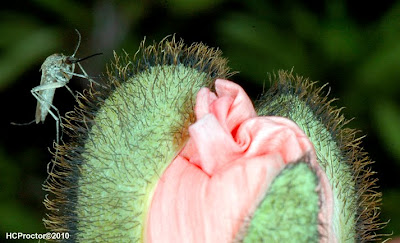As I expected, yet another cold front has hit Edmonton. Below normal and wet is dragging through its 6th day and making a muddy mess of the May Long Weekend – traditional time to plant-out one’s annuals & veggies here on the northern edge of Zone 3. Oh well, the basement spiders don’t seem to mind the snow mixed with rain. The wet grey does tend to bring out the green and certainly has been good for all the plants I’ve already impatiently planted-out. No frost yet and we wish Itztlacoliuhqui full speed south (from the predictions, though, tomorrow morning is iffy). I’ve dead-headed the spent tulips and daffodils, but it is too muddy and cold to do more. Perhaps I should be doing responsible things like Spring cleaning, and then there is that mountain of unfinished work, but instead I’ve been irresponsibly indulging myself in the bug blogs.
Best discovery so far, thanks to an old 2008 post by Chris Taylor at Catalogue of Organisms has been Attercopus fimbriunguis - a Devonian fossil on the way to (or perhaps just in) the spiders. Problematic characters include a whip-tail, no distinct spinnerets (but fossil silk), and no poison glands (although modern segmented spiders apparently never had poison glands and at least one more modern family, Uloboridae, does without them). According to the Wikipedia article (at least at this moment) the generic name is from the Old English attorcoppa for "poison-head", clearly a misnomer in this case.
Fear of “poison-heads” is called arachnophobia – and it is true that most modern spiders produce venom. Few, however, have venoms that we need to be afraid of, which makes the apparently widespread fear of spiders amongst bug bloggers even more interesting. Today’s surprise confession was from the Dragonfly Woman, but it reminded me that arachnophobia runs the bug blog gamut from the bug-photography god-like heights of myrmecos to rock-bottom-up The Geek in Question. “Very interesting” (as former colleague and mammal-tooth-fancier Gordon Sanson might put it).
The Dragonfly Woman’s story comes from her teenage years and a fishing spider in her pool. So, perfect chance for me to drag up our own cherished male Dolomedes triton hanging out around our year old pond. Alas, I fear the male found no fair female and had to bugger off to an uncertain future (probably a more common fate for wandering male spiders than being eaten by their objects of desire). My wife and I, however, were delighted that he stopped by and only wish that more and bigger spiders would take up residence. Yes, we have no Arachnophobia (but are considering buying a dvd of the movie – which features an impressive cast of mostly Australian spiders, a moderately entertaining [if factually confused] script, and good, campy acting).So, before I get serious about not enjoying my wet weeked and get out my kneepads and start cleaning out the lower kitchen cabinets, let me showcase a few of the interesting spiders that have been lurking around the Home Bug Garden. This is Alberta, so usually the only big scary spiders occur in the Autumn (especially the Jewel Spider) or in the basement (and those introduced buggers, Tegenaria domestica, and perhaps a hobo or two, do get big, hairy, and disconcerting - although the cats like them). Also, smaller spiders seem more likely to ignore a big black camera being poked at them, and so, are more photogenic.
 |
| Actually Araneus trifolium - gemmoides has two humps on its abdomen |
 |
| Actually a theridiid - probably Crustulina sticta |
 |
| Tetragnatha is the correct spelling |
 |
| Phylonetta impressa (formerly Theridion impressum) |


















